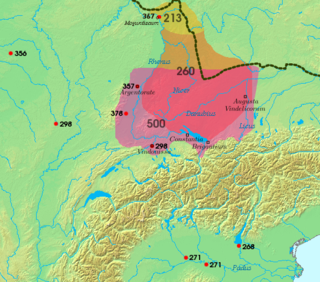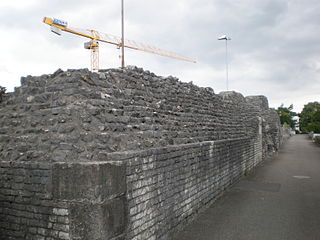
The Alemanni or Alamanni were a confederation of Germanic tribes on the Upper Rhine River during the first millennium. First mentioned by Cassius Dio in the context of the campaign of Roman emperor Caracalla of 213, the Alemanni captured the Agri Decumates in 260, and later expanded into present-day Alsace and northern Switzerland, leading to the establishment of the Old High German language in those regions, which by the eighth century were collectively referred to as Alamannia.

Basel, also known as Basle, is a city in northwestern Switzerland on the River Rhine. Basel is Switzerland's third-most-populous city, with 177,595 inhabitants within the city municipality limits. The official language of Basel is Swiss Standard German and the main spoken language is the local Basel German dialect.

Basel-Landschaft or Basel-Country, informally known as Baselland or Baselbiet, is one of the 26 cantons forming the Swiss Confederation. It is composed of five districts and its capital city is Liestal. It is traditionally considered a "half-canton", the other half being Basel-Stadt, its urban counterpart.

The early history of Switzerland begins with the earliest settlements up to the beginning of Habsburg rule, which in 1291 gave rise to the independence movement in the central cantons of Uri, Schwyz, and Unterwalden and the growth of the Old Swiss Confederacy during the Late Middle Ages.

Augusta Raurica is a Roman archaeological site and an open-air museum in Switzerland located on the south bank of the Rhine river about 20 km east of Basel near the villages of Augst and Kaiseraugst. It is the site of the oldest known Roman colony on the Rhine.

Kaiseraugst is a municipality in the district of Rheinfelden in the canton of Aargau in Switzerland. It is named after the Ancient Roman city of Augusta Raurica whose ruins are nearby. The prefix Kaiser- ("imperial") refers to the fact that from medieval times the town formed part of the Habsburg territory of Further Austria, as opposed to the neighbouring village of Augst, which was part of the Canton of Basel in the Old Swiss Confederacy.

Augst is a municipality in the district of Liestal in the canton of Basel-Country in Switzerland. It was known as Augusta Raurica in Roman times.

The Rauraci or Raurici were a small Gallic tribe dwelling in the Upper Rhine region, around the present-day city of Basel, during the Iron Age and the Roman period.

The territory of modern Switzerland was a part of the Roman Republic and Empire for a period of about six centuries, beginning with the step-by-step conquest of the area by Roman armies from the 2nd century BC and ending with the Fall of the Western Roman Empire in the 5th century AD.

Basel-Münsterhügel is the site of an Iron Age fort or oppidum, known as Basel oppidum, constructed by the Gaulish Rauraci after the battle of Bibracte in 58 BC. It the site of Basel Minster, in the Swiss city of Basel.
The following is a timeline of the history of the municipality of Zürich, Switzerland.
Timeline of Augsburg, Bavaria, Germany.
The following is a timeline of the history of the municipality of Geneva, Switzerland.
The following is a timeline of the history of the municipality of Bern, Switzerland.
The following is a timeline of the history of the municipality of Utrecht, Netherlands.
The following is a timeline of the history of the city of Mainz, Germany.
The following is a timeline of the history of the city of Ljubljana, Slovenia.
The following is a timeline of the history of the city of Perugia in the Umbria region of Italy.
The following is a timeline of the history of the city of Syracuse, Sicily, Italy. Syracuse was the main city of Sicily from 5th century BCE to 878 CE.

The Amphitheatre of Catrum Rauracense is the youngest known surviving Roman amphitheatre across the entire Roman Empire. It is located in the ancient Roman fort of Castrum Rauracense, near Kaiseraugst, Switzerland and only ruins survive today. It is the eighth Roman amphitheatre discovered in Switzerland to date.











